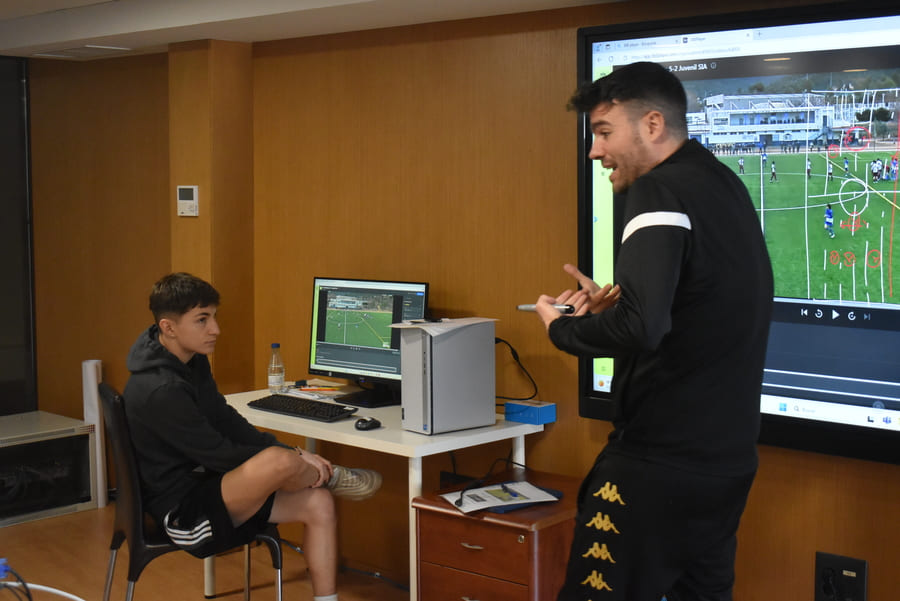Football has always been a sport where individual talent and collective strategy make the difference. However, in recent years a new silent protagonist has emerged that is completely transforming the way of training: Big Data. Thanks to the massive collection of information, top-level teams and academies can now optimize performance, prevent injuries, and design personalized training sessions that were once unthinkable.
In centers like SIA Academy, where the comprehensive development of the footballer is a priority, the use of Big Data is no longer optional: it is an essential part of daily work. As Alain, coach and specialist in video analysis at the academy, states: “Data allows us to go beyond what we see at first glance. Today we can measure everything, and that gives us a huge advantage when preparing players.”
Below, we take a look at the main ways Big Data has changed the way of training in modern football.
Table of contents
From instinct to precise data
Barely two decades ago, a coach had to base much of his decision-making on observation and intuition. Now, GPS devices, smart cameras, and analysis programs generate thousands of data points for every training session and match. The difference is radical: what used to be a subjective perception is now backed by objective evidence.
At SIA Academy, for example, each training session is monitored to know the distance covered, sprint intensity, or the areas of the pitch most used by a player. That information makes it possible to adjust workloads and design specific tasks that improve efficiency.

Individualized training
One of the greatest contributions of Big Data is the ability to personalize. Each player has different characteristics and needs, and thanks to data analysis, tailor-made plans can be created to enhance strengths and correct weaknesses.
A midfielder with great passing ability but a deficit in reaction speed receives specific training sessions to improve that area. A striker with low participation in aerial duels can work extra on jumping and positioning.
Big Data ensures that every minute of training has a concrete purpose, adapted to the individual profile.
Injury prevention and load control
Injuries have historically been one of footballers’ greatest enemies. Here, Big Data has brought a crucial change. Records of physical load, heart rate, sleep quality, and recovery allow coaches to detect signs of overexertion before an injury appears. If a player accumulates too much high-intensity workload in just a few days, the system alerts the staff. Loads are then adjusted, and recovery sessions are introduced. This approach not only protects the athlete’s health but also optimizes continuity in competitive development.
In-depth tactical analysis
Big Data has also revolutionized tactical understanding. Video analysis platforms process thousands of events per match: completed passes, recoveries, losses, positioning, among others. This allows coaches to see patterns invisible to the naked eye.
Alain explains it this way: “With video analysis and Big Data, we can show a player not only what he did right or wrong, but the exact context in which it happened. That speeds up his learning and improves decision-making on the pitch.”
At academies like SIA Academy, this information translates into very specific tactical training sessions, adjusted to the competitive reality of each team.
Real-time decisions
Another advantage of Big Data is immediacy. With GPS technology and tracking cameras, data is received live during training sessions or matches. This offers the coach the possibility of making substitutions, changing formations, or adjusting intensity based on instant information.
For example, if a player shows signs of muscle fatigue earlier than expected, he can be substituted to prevent injury. The ability to react in real time makes an enormous difference compared to the traditional method of waiting for “what the eye perceives.”

Development of young talents
In training academies, Big Data has become a fundamental tool to guide growing footballers. Measuring metrics from an early age allows coaches to detect specific talents and design development paths more suited to their characteristics.
A youth player who shows outstanding endurance in repeated efforts can be profiled for high-workload positions, while another with great precision in risky passes may be oriented towards a creative role in midfield.
This approach helps the player understand that football is not just intuition and talent, but also constant work backed by objective data.
Challenges of Big Data in football
Not everything is an advantage. Big Data also brings challenges. The first is information overload: thousands of data points can be useless if not interpreted correctly. This is why the role of the analyst and the video analysis specialist is now more relevant than ever.
In addition, there is the risk of depending too heavily on statistics, forgetting that football is still a sport with emotional factors and unpredictable situations. The balance between data and human experience remains essential.
Big Data has stopped being a trend and has become the backbone of modern football. From preventing injuries to improving tactics or personalizing training, information has been integrated into every stage of the training and competitive process.
At top-level centers like SIA Academy, the use of these tools gives young players preparation that matches professional standards. Because, as Alain sums it up: “Data doesn’t play for you, but it shows you where you can be better. And that knowledge is power on the pitch.”






